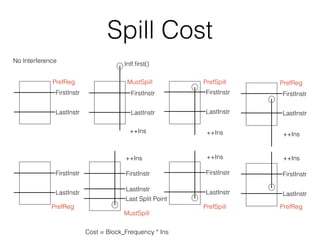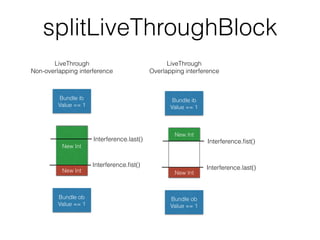LLVM Register Allocation
- 2. Outline • Introduction to Register Allocation Problem • LLVM Base Register Allocation Interface • LLVM Basic Register Allocation • LLVM Greedy Register Allocation
- 3. Introduction to Register Allocation • Definition • Register allocation is the problem of mapping program variables to either machine registers or memory addresses. • Best solution • minimise the number of loads/stores from/to memory • NP-complete
- 4. int main() { int i, j; int answer; for (i = 1; i < 10; i++) for (j = 1; j < 10; j++) { answer = i * j; } return 0; } _main: @ BB#0: sub sp, #16 movs r0, #0 str r0, [sp, #12] movs r0, #1 str r0, [sp, #8] b LBB0_2 LBB0_1: adds r1, #1 str r1, [sp, #8] LBB0_2: ldr r1, [sp, #8] cmp r1, #9 bgt LBB0_6 @ BB#3: str r0, [sp, #4] b LBB0_5 LBB0_4: ldr r2, [sp, #4] muls r1, r2, r1 str r1, [sp] ldr r1, [sp, #4] adds r1, #1
- 5. Graph Coloring • For an arbitrary graph G; a coloring of G assigns a color to each node in G so that no pair of adjacent nodes have the same color. 2-colorable 3-colorable
- 6. Graph Coloring for RA • Node: Live interval • Edge: Two live intervals have interference • Color: Physical register • Find a feasible colouring for the graph
- 7. … a0 = … b0 = … … = b0 d0 = … c0 = … … d1 = c0 … = a0 … = d1 B0 B1 B2 B3 … LIa = … LIb = … … = LIb LIc = … … LId = LIc … = LIa … = LId B0 B1 B2 B3
- 8. LRa LRb LRc LRd … LIa = … LIb = … … = LIb LIc = … … LId = LIc … = LIa … = LId B0 B1 B2 B3 An Example from “Engineering A Compiler”
- 9. Why Not Graph Coloring • Interference graph is expensive to build • Spill code placement is more important than colouring • Need to model aliases and overlapping register classes • Flexibility is more important than the coloring algorithm (Adopted from “Register Allocation in LLVM 3.0”)
- 10. Excerpt from tricore_llvm.pdf SSA Properties * Each definition in the procedure creates a unique name. * Each use refers to a single definition.
- 11. LLVM Register Allocation • Basic • Provide a minimal implementation of the basic register allocator • Greedy • Global live range splitting. • Fast • This register allocator allocates registers to a basic block at a time. • PBQP • Partitioned Boolean Quadratic Programming (PBQP) based register allocator for LLVM
- 12. LLVM Base Register Allocation Interface Calculate LiveInterval Weight Enqueue All LiveInterval selectOrSplit for One LiveInterval Assign the Physical Register Enqueue Split LiveInterval dequeue physical register is available split live interval update LiveInterval.weight (spill cost) allocatePhysRegs enqueue seedLiveRegs Q customised by new RA algorithm for (unsigned i = 0, e = MRI->getNumVirtRegs(); i != e; ++i) { unsigned Reg = TargetRegisterInfo::index2VirtReg(i); if (MRI->reg_nodbg_empty(Reg)) continue; enqueue(&LIS->getInterval(Reg)); }
- 13. LLVM Basic Register Allocation Calculate LiveInterval Weight Enqueue All LiveInterval RABasic::selectOrSplit Assign the Physical Register Enqueue Split LiveInterval dequeue physical register is available split live interval update LiveInterval.weight (spill cost) allocatePhysRegs enqueue seedLiveRegs priority Q (spill cost) customised by RABasic algorithm struct CompSpillWeight { bool operator()(LiveInterval *A, LiveInterval *B) const { return A->weight < B->weight; } }; // Check for an available register in this class. AllocationOrder Order(VirtReg.reg, *VRM, RegClassInfo); while (unsigned PhysReg = Order.next()) { // Check for interference in PhysReg switch (Matrix->checkInterference(VirtReg, PhysReg)) { case LiveRegMatrix::IK_Free: // PhysReg is available, allocate it. return PhysReg; case LiveRegMatrix::IK_VirtReg: // Only virtual registers in the way, we may be able to spill them. PhysRegSpillCands.push_back(PhysReg); continue; default: // RegMask or RegUnit interference. continue; } }
- 14. LiveInterval Weight • Weight for one instruction with the register • weight = (isDef + isUse) * (Block Frequency / Entry Frequency) • loop induction variable: weight *= 3 • For all instructions with the register • totalWeight += weight • Hint: totalWeight *= 1.01 • Re-materializable: totalWeight *= 0.5 • LiveInterval.weight = totalWeight / size of LiveInterval
- 15. Matrix->checkInterference() • How to represent live/dead points? • SlotIndex • How to represent a value? • VNInfo • How to represent a live interval? • LiveInterval • How to check interference between live intervals? • LiveIntervalUnion & LiveRegMatrix
- 16. Liveness Slot • There are four kind of slots to describe a position at which a register can become live, or cease to be live. • Block (B) • entering or leaving a block • PHI-def • Early Clobber (e) • kill slot for early-clobber def • A = A op B ( ) • Register (r) • normal register use/def slot • Dead (d) • dead def ********** INTERVALS ********** %vreg0 [208r,320r:0)[416B,432r:0) 0@208r %vreg1 [16r,32r:0) 0@16r %vreg2 [48r,480B:0) 0@48r %vreg3 [96r,112r:0) 0@96r %vreg4 [496r,512r:0) 0@496r %vreg6 [224r,240r:0) 0@224r %vreg7 [432r,448r:0) 0@432r %vreg8 [304r,320r:0) 0@304r %vreg9 [320r,336r:0) 0@320r %vreg10 [352r,368r:0) 0@352r %vreg11 [368r,384r:0) 0@368r
- 17. SlotIndex ((MachineInstr *, index), slot) Slot_Block Slot_EarlyClobber Slot_Register Slot_Dead unsigned getIndex() const { return listEntry()->getIndex() | getSlot(); } listEntry()
- 18. Numbering of Machine Instruction 0B BB#0: derived from LLVM BB %entry 16B %vreg1<def> = t2MOVi 0, pred:14, pred:%noreg, opt:%noreg; rGPR:%vreg1 32B t2STRi12 %vreg1, <fi#0>, 0, pred:14, pred:%noreg; mem:ST4[%retval] rGPR:%vreg1 48B %vreg2<def> = t2MOVi 1, pred:14, pred:%noreg, opt:%noreg; rGPR:%vreg2 64B t2STRi12 %vreg2, <fi#1>, 0, pred:14, pred:%noreg; mem:ST4[%i] rGPR:%vreg2 Successors according to CFG: BB#1 for (MachineBasicBlock::iterator miItr = mbb->begin(), miEnd = mbb->end(); miItr != miEnd; ++miItr) { MachineInstr *mi = miItr; if (mi->isDebugValue()) continue; // Insert a store index for the instr. indexList.push_back(createEntry(mi, index += SlotIndex::InstrDist)); // Save this base index in the maps. mi2iMap.insert(std::make_pair(mi, SlotIndex(&indexList.back(), SlotIndex::Slot_Block))); }
- 19. VNInfo • hold information about a machine level value • (id, def) • def: SlotIndex of the defining instruction
- 20. Live Interval • Segment • start, end, valno • LiveRange • an ordered list of Segment • LiveInterval • LiveRange with register and weight (spill cost) ********** INTERVALS ********** %vreg0 [208r,320r:0)[416B,432r:0) 0@208r %vreg1 [16r,32r:0) 0@16r %vreg2 [48r,480B:0) 0@48r %vreg3 [96r,112r:0) 0@96r %vreg4 [496r,512r:0) 0@496r %vreg6 [224r,240r:0) 0@224r %vreg7 [432r,448r:0) 0@432r %vreg8 [304r,320r:0) 0@304r %vreg9 [320r,336r:0) 0@320r %vreg10 [352r,368r:0) 0@352r %vreg11 [368r,384r:0) 0@368r Segment LiveRange LiveInterval VNInfo
- 21. Example 192B BB#3: derived from LLVM BB %for.cond.1 208B %vreg0<def> = t2LDRi12 <fi#1>, 0 224B %vreg6<def> = t2LDRi12 <fi#2>, 0 240B t2CMPri %vreg6, 9 256B t2Bcc <BB#5> 272B t2B <BB#4> 416B BB#5: derived from LLVM BB %for.inc.4 432B %vreg7<def> = t2ADDri %vreg0, 1 448B t2STRi12 %vreg7, <fi#1>, 0 ********** INTERVALS ********** %vreg0 [208r,320r:0)[416B,432r:0) 0@208r %vreg1 [16r,32r:0) 0@16r %vreg2 [48r,480B:0) 0@48r %vreg3 [96r,112r:0) 0@96r %vreg4 [496r,512r:0) 0@496r %vreg6 [224r,240r:0) 0@224r %vreg7 [432r,448r:0) 0@432r %vreg8 [304r,320r:0) 0@304r %vreg9 [320r,336r:0) 0@320r %vreg10 [352r,368r:0) 0@352r %vreg11 [368r,384r:0) 0@368r 288B BB#4: derived from LLVM BB %for.body.3 304B %vreg8<def> = t2LDRi12 <fi#2>, 0 320B %vreg9<def> = t2MUL %vreg0, %vreg8 336B t2STRi12 %vreg9, <fi#3>, 0 352B %vreg10<def> = t2LDRi12 <fi#2>, 0 368B %vreg11<def> = t2ADDri %vreg10, 1 384B t2STRi12 %vreg11, <fi#2>, 0 400B t2B <BB#3> 208r 320r 416B 432r
- 22. LiveRegMatrix AH AL BH BL XMM31 V3 V3 V5 V0 V4 V1 V2 V6 RegUnit LiveIntervalUnion EAX => AH, AL AX => AH, AL AH => AH AL => AL
- 23. Check Interference unsigned LiveIntervalUnion::Query:: collectInterferingVRegs(unsigned MaxInterferingRegs) { … // Check for overlapping interference. while (VirtRegI->start < LiveUnionI.stop() && VirtRegI->end > LiveUnionI.start()) { // This is an overlap, record the interfering register. LiveInterval *VReg = LiveUnionI.value(); if (VReg != RecentReg && !isSeenInterference(VReg)) { RecentReg = VReg; InterferingVRegs.push_back(VReg); if (InterferingVRegs.size() >= MaxInterferingRegs) return InterferingVRegs.size(); } // This LiveUnion segment is no longer interesting. if (!(++LiveUnionI).valid()) { SeenAllInterferences = true; return InterferingVRegs.size(); } } … } LiveIntervalUnion VirtReg start() stop() start end start() stop() start end start() stop() start end start() stop() start end
- 24. Check Interference AH AL BH BL XMM31 V3 V3 V5 V0 V4 V1 V2 V6 V7 // Check the matrix for virtual register interference. for (MCRegUnitIterator Units(PhysReg, TRI); Units.isValid(); ++Units) if (query(VirtReg, *Units).checkInterference()) return IK_VirtReg;
- 26. Use Split to Improve RA • Live Range Splitting • Insert copy/re-materialize to split up live ranges • hopefully reduces need for spilling • Also control spill code placement
- 27. • Example Q0 D0 D1 Q1 D2 D3 V1 V2 V3 V4 V5
- 28. Q0 D0 D1 Q1 D2 D3 V1 V2 V3 V4 V5
- 29. • No physical register for V1 Q0 D0 D1 Q1 D2 D3 V1 V2 V3 V4 V5
- 30. • Evict V2 Q0 D0 D1 Q1 D2 D3 V1 V2 V3V4 V5 stack
- 31. • Split V2 Q0 D0 D1 Q1 D2 D3 V1 V2b V3V4 V5 V2a V2c
- 32. • Split V2 Q0 D0 D1 Q1 D2 D3 V1 V2b V3V4 V5 V2a V2c stack
- 33. Greedy RA Stages • RS_New: created • RS_Assign: enqueue • RS_Split: need to split • RS_Split2 • used for split products that may not be making progress • RS_Spill: need to spill • RS_Done: assigned a physical register or created by spill
- 34. RS_Split2 • The live intervals created by split will enqueue to process again. • There is a risk of creating infinite loops. … = vreg1 … … = vreg1 … … = vreg1 … vreg2 = COPY vreg1 … = vreg2 … vreg3 = COPY vreg1 … = vreg3 … … = vreg3 … RS_New RS_Split2
- 35. Greedy Register Allocation try to assign physical register (hint > zero cost reg > low cost reg) try to evict to find better register enter RS_Split stage try last chance recoloring split spill pick a physical register and evict all interference found register stage >= RS_Done stage < RS_Split selectOrSplit(d+1) enter RS_Done stage selectOrSplit(d)
- 36. Last Chance Recoloring • Try to assign a color to VirtReg by recoloring its interferences. • The recoloring process may recursively use the last chance recoloring. Therefore, when a virtual register has been assigned a color by this mechanism, it is marked as Fixed. vA can use {R1, R2 } vB can use { R2, R3} vC can use {R1 } vA => R1 vB => R2 vC => fails vA => R2 vB => R3 vC => R1 (fixed)
- 37. How to Split? is stage beyond RS_Spill? is in one BB? tryLocalSplit tryInstructionSplit No Yes tryRegionSplit is stage less than RS_Split2? No spill Yes success? No success? spill No tryBlockSplit Yes No success? No success? spill No done Yes Yes done Yes Yes
- 38. BlockInfo (LiveIn) (LiveOut) FirstInstr: First instruction accessing current reg. LastInstr: Last instruction accessing current reg. Live-through blocks without any uses don’t get BlockInfo entries.
- 39. tryLocalSplit • Try to split virtual register interval into smaller intervals inside its only basic block. • calculate gap weights • adjust the split region
- 40. Calculate Gap Weights NumGaps = 4
- 41. Calculate Gap Weights LI.weight VirtReg LI If there is a RegUnit occupied by VirtReg:0 0
- 42. Calculate Gap Weights LI.weight Fixed RegUnit If there is a fixed RegUnit:0 0 huge_valf
- 43. Adjust Split Region SplitAfter = 1 SplitBefore = 0 normalise spill weight > max gap BestBefore = SplitBefore BestAfter = SplitAfter SplitAfter++ SplitBefore++ YesNo normalise spill weight = spill cost / distance = (#gap * block_freq) / distance(SplitBefore, SplitAfter)
- 44. Adjust Split Region BestAfter BestBefore normalise spill weight > max gap BestBefore = SplitBefore BestAfter = SplitAfter SplitAfter++ SplitBefore++ YesNo normalise spill weight = spill cost / distance = (#gap * block_freq) / distance(SplitBefore, SplitAfter) RS_New (or RS_Split2) RS_New Find the most critical range.
- 45. tryInstructionSplit • Split a live range around individual instructions. • Every “use” instruction has its own live interval.
- 46. tryBlockSplit • Split a global live range around every block with uses. FirstInstr LastInstr
- 47. tryRegionSplit • For every physical register • Prepare interference cache • Construct Hopfield Network • Construct block constraints • Update Hopfield Network biases and values according to block constraints • Add links in Hopfield Network and iterate • Get the best candidate (minimize split cost + spill cost) • Do region split
- 48. Hopfield Network • A form of recurrent artificial neural network popularised by John Hopfield in 1982. • Guaranteed to converge to a local minimum.
- 49. Hopfield Network • Node: edge bundle • Link: transparent basic blocks have the variable live through. • Energy function (the cost of spilling) • Weight: block frequency • Bias: according to block constraints
- 50. Block Constraints No Interference PrefReg Intf.first() MustSpill PrefSpill FirstInstr LastInstr PrefReg FirstInstr LastInstr FirstInstr LastInstr FirstInstr LastInstr PrefReg MustSpill FirstInstr LastInstr PrefReg FirstInstr LastInstr FirstInstr LastInstr FirstInstr LastInstr PrefSpill Last Split Point
- 51. Edge Bundle BB #0 BB #1 BB #3 BB #2 BB #4 BB #5 BB #6 // Join the outgoing bundle with the ingoing bundles of all successors. for (MachineBasicBlock::const_succ_iterator SI = MBB.succ_begin(), SE = MBB.succ_end(); SI != SE; ++SI) EC.join(OutE, 2 * (*SI)->getNumber()); EC: (BB#0, in) Bundle #0: 0 0 0 (BB#0, out) Bundle #1: 1 1 1 (BB#1, in) Bundle #2: 2 1 1 (BB#1, out) Bundle #3: 3 3 2 (BB#2, in) Bundle #4: 4 3 2 (BB#2, out) Bundle #5: 5 5 3 (BB#3, in) Bundle #6: 6 5 3 (BB#3, out) Bundle #7: 7 7 4 (BB#4, in) Bundle #8: 8 7 4 (BB#4, out) Bundle #9: 9 5 3 (BB#5, in) Bundle #10: 10 7 4 (BB#5, out) Bundle #11: 11 1 1 (BB#6, in) Bundle #12: 12 3 2 (BB#6, out) Bundle #13: 13 13 5 void join(unsigned a, unsigned b) { unsigned eca = EC[a]; unsigned ecb = EC[b]; while (eca != ecb) if (eca < ecb) EC[b] = eca, b = ecb, ecb = EC[b]; else EC[a] = ecb, a = eca, eca = EC[a]; }
- 52. Edge Bundle BB #0 BB #1 BB #3 BB #2 BB #4 BB #5 BB #6 Blocks: Bundle #0: BB#0 Bundle #1: BB#0, BB#1, BB#5 Bundle #2: BB#1, BB#2, BB#6 Bundle #3: BB#2, BB#3, BB#4 Bundle #4: BB#3, BB#4, BB#5 Bundle #5: BB#6 Bundle #6: Bundle #7: Bundle #8: Bundle #9: Bundle #10: Bundle #11: Bundle #12: Bundle #13: EC: (BB#0, in) Bundle #0: 0 0 0 (BB#0, out) Bundle #1: 1 1 1 (BB#1, in) Bundle #2: 2 1 1 (BB#1, out) Bundle #3: 3 3 2 (BB#2, in) Bundle #4: 4 3 2 (BB#2, out) Bundle #5: 5 5 3 (BB#3, in) Bundle #6: 6 5 3 (BB#3, out) Bundle #7: 7 7 4 (BB#4, in) Bundle #8: 8 7 4 (BB#4, out) Bundle #9: 9 5 3 (BB#5, in) Bundle #10: 10 7 4 (BB#5, out) Bundle #11: 11 1 1 (BB#6, in) Bundle #12: 12 3 2 (BB#6, out) Bundle #13: 13 13 5
- 53. Edge Bundle BB #0 BB #1 BB #3 BB #2 BB #4 BB #5 BB #6 Blocks: Bundle #0: BB#0 Bundle #1: BB#0, BB#1, BB#5 Bundle #2: BB#1, BB#2, BB#6 Bundle #3: BB#2, BB#3, BB#4 Bundle #4: BB#3, BB#4, BB#5 Bundle #5: BB#6 Bundle #6: Bundle #7: Bundle #8: Bundle #9: Bundle #10: Bundle #11: Bundle #12: Bundle #13: EC: (BB#0, in) Bundle #0: 0 0 0 (BB#0, out) Bundle #1: 1 1 1 (BB#1, in) Bundle #2: 2 1 1 (BB#1, out) Bundle #3: 3 3 2 (BB#2, in) Bundle #4: 4 3 2 (BB#2, out) Bundle #5: 5 5 3 (BB#3, in) Bundle #6: 6 5 3 (BB#3, out) Bundle #7: 7 7 4 (BB#4, in) Bundle #8: 8 7 4 (BB#4, out) Bundle #9: 9 5 3 (BB#5, in) Bundle #10: 10 7 4 (BB#5, out) Bundle #11: 11 1 1 (BB#6, in) Bundle #12: 12 3 2 (BB#6, out) Bundle #13: 13 13 5
- 54. Edge Bundle BB #0 BB #1 BB #3 BB #2 BB #4 BB #5 BB #6 Blocks: Bundle #0: BB#0 Bundle #1: BB#0, BB#1, BB#5 Bundle #2: BB#1, BB#2, BB#6 Bundle #3: BB#2, BB#3, BB#4 Bundle #4: BB#3, BB#4, BB#5 Bundle #5: BB#6 Bundle #6: Bundle #7: Bundle #8: Bundle #9: Bundle #10: Bundle #11: Bundle #12: Bundle #13: EC: (BB#0, in) Bundle #0: 0 0 0 (BB#0, out) Bundle #1: 1 1 1 (BB#1, in) Bundle #2: 2 1 1 (BB#1, out) Bundle #3: 3 3 2 (BB#2, in) Bundle #4: 4 3 2 (BB#2, out) Bundle #5: 5 5 3 (BB#3, in) Bundle #6: 6 5 3 (BB#3, out) Bundle #7: 7 7 4 (BB#4, in) Bundle #8: 8 7 4 (BB#4, out) Bundle #9: 9 5 3 (BB#5, in) Bundle #10: 10 7 4 (BB#5, out) Bundle #11: 11 1 1 (BB#6, in) Bundle #12: 12 3 2 (BB#6, out) Bundle #13: 13 13 5
- 55. Edge Bundle BB #0 BB #1 BB #3 BB #2 BB #4 BB #5 BB #6 Blocks: Bundle #0: BB#0 Bundle #1: BB#0, BB#1, BB#5 Bundle #2: BB#1, BB#2, BB#6 Bundle #3: BB#2, BB#3, BB#4 Bundle #4: BB#3, BB#4, BB#5 Bundle #5: BB#6 Bundle #6: Bundle #7: Bundle #8: Bundle #9: Bundle #10: Bundle #11: Bundle #12: Bundle #13: EC: (BB#0, in) Bundle #0: 0 0 0 (BB#0, out) Bundle #1: 1 1 1 (BB#1, in) Bundle #2: 2 1 1 (BB#1, out) Bundle #3: 3 3 2 (BB#2, in) Bundle #4: 4 3 2 (BB#2, out) Bundle #5: 5 5 3 (BB#3, in) Bundle #6: 6 5 3 (BB#3, out) Bundle #7: 7 7 4 (BB#4, in) Bundle #8: 8 7 4 (BB#4, out) Bundle #9: 9 5 3 (BB#5, in) Bundle #10: 10 7 4 (BB#5, out) Bundle #11: 11 1 1 (BB#6, in) Bundle #12: 12 3 2 (BB#6, out) Bundle #13: 13 13 5
- 56. Edge Bundle BB #0 BB #1 BB #3 BB #2 BB #4 BB #5 BB #6 Blocks: Bundle #0: BB#0 Bundle #1: BB#0, BB#1, BB#5 Bundle #2: BB#1, BB#2, BB#6 Bundle #3: BB#2, BB#3, BB#4 Bundle #4: BB#3, BB#4, BB#5 Bundle #5: BB#6 Bundle #6: Bundle #7: Bundle #8: Bundle #9: Bundle #10: Bundle #11: Bundle #12: Bundle #13: EC: (BB#0, in) Bundle #0: 0 0 0 (BB#0, out) Bundle #1: 1 1 1 (BB#1, in) Bundle #2: 2 1 1 (BB#1, out) Bundle #3: 3 3 2 (BB#2, in) Bundle #4: 4 3 2 (BB#2, out) Bundle #5: 5 5 3 (BB#3, in) Bundle #6: 6 5 3 (BB#3, out) Bundle #7: 7 7 4 (BB#4, in) Bundle #8: 8 7 4 (BB#4, out) Bundle #9: 9 5 3 (BB#5, in) Bundle #10: 10 7 4 (BB#5, out) Bundle #11: 11 1 1 (BB#6, in) Bundle #12: 12 3 2 (BB#6, out) Bundle #13: 13 13 5
- 57. Edge Bundle BB #0 BB #1 BB #3 BB #2 BB #4 BB #5 BB #6 Blocks: Bundle #0: BB#0 Bundle #1: BB#0, BB#1, BB#5 Bundle #2: BB#1, BB#2, BB#6 Bundle #3: BB#2, BB#3, BB#4 Bundle #4: BB#3, BB#4, BB#5 Bundle #5: BB#6 Bundle #6: Bundle #7: Bundle #8: Bundle #9: Bundle #10: Bundle #11: Bundle #12: Bundle #13: EC: (BB#0, in) Bundle #0: 0 0 0 (BB#0, out) Bundle #1: 1 1 1 (BB#1, in) Bundle #2: 2 1 1 (BB#1, out) Bundle #3: 3 3 2 (BB#2, in) Bundle #4: 4 3 2 (BB#2, out) Bundle #5: 5 5 3 (BB#3, in) Bundle #6: 6 5 3 (BB#3, out) Bundle #7: 7 7 4 (BB#4, in) Bundle #8: 8 7 4 (BB#4, out) Bundle #9: 9 5 3 (BB#5, in) Bundle #10: 10 7 4 (BB#5, out) Bundle #11: 11 1 1 (BB#6, in) Bundle #12: 12 3 2 (BB#6, out) Bundle #13: 13 13 5
- 58. Edge Bundle BB #0 BB #1 BB #3 BB #2 BB #4 BB #5 BB #6 Blocks: Bundle #0: BB#0 Bundle #1: BB#0, BB#1, BB#5 Bundle #2: BB#1, BB#2, BB#6 Bundle #3: BB#2, BB#3, BB#4 Bundle #4: BB#3, BB#4, BB#5 Bundle #5: BB#6 Bundle #6: Bundle #7: Bundle #8: Bundle #9: Bundle #10: Bundle #11: Bundle #12: Bundle #13: EC: (BB#0, in) Bundle #0: 0 0 0 (BB#0, out) Bundle #1: 1 1 1 (BB#1, in) Bundle #2: 2 1 1 (BB#1, out) Bundle #3: 3 3 2 (BB#2, in) Bundle #4: 4 3 2 (BB#2, out) Bundle #5: 5 5 3 (BB#3, in) Bundle #6: 6 5 3 (BB#3, out) Bundle #7: 7 7 4 (BB#4, in) Bundle #8: 8 7 4 (BB#4, out) Bundle #9: 9 5 3 (BB#5, in) Bundle #10: 10 7 4 (BB#5, out) Bundle #11: 11 1 1 (BB#6, in) Bundle #12: 12 3 2 (BB#6, out) Bundle #13: 13 13 5
- 59. SpillPlacement::addConstraints • update BiasN, BiasP according to BorderConstraint BB #n (freq) … = Y op … PrefReg PrefSpill Bundle ib BiasP += freq Bundle ob BiasN += freq void addBias(BlockFrequency freq, BorderConstraint direction) { switch (direction) { default: break; case PrefReg: BiasP += freq; break; case PrefSpill: BiasN += freq; break; case MustSpill: BiasN = BlockFrequency::getMaxFrequency(); // (uint64_t)-1ULL break; } }
- 60. Hopfield Network Node • Node.update(nodes, Threshold) Bundle X BiasN BiasP Value Bundle A Value = -1 Bundle B Value = 1 Bundle C Value = 1 Bundle D Value = 1 Links SumN = BiasN + freqA SunP = BiasP + freqB + freqC + freqD (freqA, A) (freqB, B) (freqC, C) (freqD, D) if (SumN >= SumP + Threshold) Value = -1; else if (SumP >= SumN + Threshold) Value = 1; else Value = 0;
- 61. Grow Region • Live through blocks in positive bundles. No Interference Intf.first() MustSpill PrefSpill Used as links between bundles SpillPlacement::addConstraints Intf.last() MustSpill PrefSpill
- 62. SpillPlacement::addLinks BB #n (freq) Bundle ib Bundle ob Bundle ib Bundle ob (freq, ob) (freq, ib)
- 63. SpillPlacement::iterate for (unsigned iteration = 0; iteration != 10; ++iteration) { bool Changed = false; for (SmallVectorImpl<unsigned>::const_reverse_iterator I = iteration == 0 ? Linked.rbegin() : std::next(Linked.rbegin()), E = Linked.rend(); I != E; ++I) { unsigned n = *I; if (nodes[n].update(nodes, Threshold)) { Changed = true; if (nodes[n].preferReg()) RecentPositive.push_back(n); } } if (!Changed || !RecentPositive.empty()) return; Changed = false; for (SmallVectorImpl<unsigned>::const_iterator I = std::next(Linked.begin()), E = Linked.end(); I != E; ++I) { unsigned n = *I; if (nodes[n].update(nodes, Threshold)) { Changed = true; if (nodes[n].preferReg()) RecentPositive.push_back(n); } } if (!Changed || !RecentPositive.empty()) return; }
- 64. Spill Cost No Interference PrefReg Intf.first() MustSpill PrefSpill FirstInstr LastInstr PrefReg FirstInstr LastInstr FirstInstr LastInstr FirstInstr LastInstr PrefReg MustSpill FirstInstr LastInstr PrefReg FirstInstr LastInstr FirstInstr LastInstr FirstInstr LastInstr PrefSpill Last Split Point ++Ins ++Ins ++Ins ++Ins ++Ins ++Ins Cost = Block_Frequency * Ins
- 65. Split Cost BB #n (freq) … = Y op … Bundle ib Value Bundle ob Value Use Block RegIn RegOut BC.Entry BC.Exit if (BI.LiveIn) Ins += RegIn != (BC.Entry == SpillPlacement::PrefReg); if (BI.LiveOut) Ins += RegOut != (BC.Exit == SpillPlacement::PrefReg); while (Ins--) GlobalCost += SpillPlacer->getBlockFrequency(BC.Number); Live Through BB #n (freq) Bundle ib Value Bundle ob Value RegIn RegOut RegIn RegOut Cost 0 0 0 0 1 freq 1 0 freq 1 1 2 x freq (interfer)
- 66. The Best Candidate • For all physical registers, calculate region split cost. • Cost = block constraints cost (spill cost) + global split cost • The best candidate has the lowest cost.
- 67. Split • splitLiveThroughBlock • splitRegInBlock • splitRegOutBlock
- 68. splitLiveThroughBlock Bundle ib Value == 1 Bundle ob Value != 1 Live Through LiveOut on Stack first non-PHI Start New Int Bundle ib Value != 1 Bundle ob Value == 1 Live Through LiveIn on Stack last split point End New Int Live Through No Interference Bundle ib Value == 1 Bundle ob Value == 1 End New Int Start
- 69. splitLiveThroughBlock Bundle ib Value == 1 Bundle ob Value == 1 LiveThrough Non-overlapping interference New Int Interference.fist() Interference.last() New Int Bundle ib Value == 1 Bundle ob Value == 1 LiveThrough Overlapping interference New Int Interference.fist() Interference.last() New Int
- 70. splitRegInBlock Bundle ib Value == 1 No LiveOut Interference after kill Start New Int Bundle ib Value == 1 Bundle ob Value != 1 LiveOut on Stack Interference after last use LiveOut on Stack Interference after last use Interference.fist() LastInstr LastInstr last split point New Int Start Bundle ib Value == 1 Bundle ob Value != 1 LastInstr last split point New Int Start Interference.fist() Interference.fist()
- 71. splitRegInBlock Bundle ib Value == 1 LiveOut on Stack Interference overlapping uses Start New Int Bundle ib Value == 1 Interference.fist() LastInstr last split point New Int Start New Int Interference.fist() LastInstr last split point New Int Bundle ob Value != 1 Bundle ob Value != 1 LiveOut on Stack Interference overlapping uses
- 72. splitRegOutBlock No LiveIn Interference before def End New Int Bundle ib Value != 1 Bundle ob Value == 1 Live Through Interference before def Live Through Interference overlapping uses Interference.last() FirstInstr Bundle ib Value != 1 Bundle ob Value == 1 Bundle ob Value == 1 End New Int Interference.last() FirstInstr last split point End New Int Interference.last() FirstInstr New Int


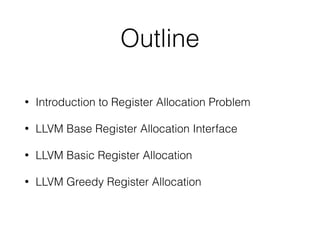

![int main()
{
int i, j;
int answer;
for (i = 1; i < 10; i++)
for (j = 1; j < 10; j++) {
answer = i * j;
}
return 0;
}
_main:
@ BB#0:
sub sp, #16
movs r0, #0
str r0, [sp, #12]
movs r0, #1
str r0, [sp, #8]
b LBB0_2
LBB0_1:
adds r1, #1
str r1, [sp, #8]
LBB0_2:
ldr r1, [sp, #8]
cmp r1, #9
bgt LBB0_6
@ BB#3:
str r0, [sp, #4]
b LBB0_5
LBB0_4:
ldr r2, [sp, #4]
muls r1, r2, r1
str r1, [sp]
ldr r1, [sp, #4]
adds r1, #1](https://image.slidesharecdn.com/llvmregisterallocation-160322143918/85/LLVM-Register-Allocation-4-320.jpg)













![Numbering of Machine
Instruction
0B BB#0: derived from LLVM BB %entry
16B %vreg1<def> = t2MOVi 0, pred:14, pred:%noreg, opt:%noreg; rGPR:%vreg1
32B t2STRi12 %vreg1, <fi#0>, 0, pred:14, pred:%noreg; mem:ST4[%retval] rGPR:%vreg1
48B %vreg2<def> = t2MOVi 1, pred:14, pred:%noreg, opt:%noreg; rGPR:%vreg2
64B t2STRi12 %vreg2, <fi#1>, 0, pred:14, pred:%noreg; mem:ST4[%i] rGPR:%vreg2
Successors according to CFG: BB#1
for (MachineBasicBlock::iterator miItr = mbb->begin(), miEnd = mbb->end();
miItr != miEnd; ++miItr) {
MachineInstr *mi = miItr;
if (mi->isDebugValue())
continue;
// Insert a store index for the instr.
indexList.push_back(createEntry(mi, index += SlotIndex::InstrDist));
// Save this base index in the maps.
mi2iMap.insert(std::make_pair(mi, SlotIndex(&indexList.back(),
SlotIndex::Slot_Block)));
}](https://image.slidesharecdn.com/llvmregisterallocation-160322143918/85/LLVM-Register-Allocation-18-320.jpg)
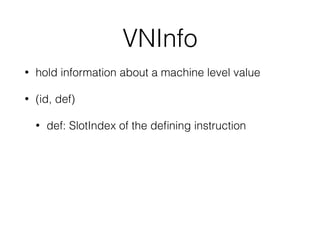


















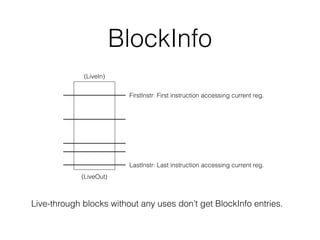












![Edge Bundle
BB #0
BB #1
BB #3
BB #2
BB #4 BB #5
BB #6
// Join the outgoing bundle with the ingoing bundles of all successors.
for (MachineBasicBlock::const_succ_iterator SI = MBB.succ_begin(),
SE = MBB.succ_end(); SI != SE; ++SI)
EC.join(OutE, 2 * (*SI)->getNumber());
EC:
(BB#0, in) Bundle #0: 0 0 0
(BB#0, out) Bundle #1: 1 1 1
(BB#1, in) Bundle #2: 2 1 1
(BB#1, out) Bundle #3: 3 3 2
(BB#2, in) Bundle #4: 4 3 2
(BB#2, out) Bundle #5: 5 5 3
(BB#3, in) Bundle #6: 6 5 3
(BB#3, out) Bundle #7: 7 7 4
(BB#4, in) Bundle #8: 8 7 4
(BB#4, out) Bundle #9: 9 5 3
(BB#5, in) Bundle #10: 10 7 4
(BB#5, out) Bundle #11: 11 1 1
(BB#6, in) Bundle #12: 12 3 2
(BB#6, out) Bundle #13: 13 13 5
void join(unsigned a, unsigned b) {
unsigned eca = EC[a];
unsigned ecb = EC[b];
while (eca != ecb)
if (eca < ecb)
EC[b] = eca, b = ecb, ecb = EC[b];
else
EC[a] = ecb, a = eca, eca = EC[a];
}](https://image.slidesharecdn.com/llvmregisterallocation-160322143918/85/LLVM-Register-Allocation-51-320.jpg)











![SpillPlacement::iterate
for (unsigned iteration = 0; iteration != 10; ++iteration) {
bool Changed = false;
for (SmallVectorImpl<unsigned>::const_reverse_iterator I =
iteration == 0 ? Linked.rbegin() : std::next(Linked.rbegin()),
E = Linked.rend(); I != E; ++I) {
unsigned n = *I;
if (nodes[n].update(nodes, Threshold)) {
Changed = true;
if (nodes[n].preferReg())
RecentPositive.push_back(n);
}
}
if (!Changed || !RecentPositive.empty())
return;
Changed = false;
for (SmallVectorImpl<unsigned>::const_iterator I =
std::next(Linked.begin()), E = Linked.end(); I != E; ++I) {
unsigned n = *I;
if (nodes[n].update(nodes, Threshold)) {
Changed = true;
if (nodes[n].preferReg())
RecentPositive.push_back(n);
}
}
if (!Changed || !RecentPositive.empty())
return;
}](https://image.slidesharecdn.com/llvmregisterallocation-160322143918/85/LLVM-Register-Allocation-63-320.jpg)
